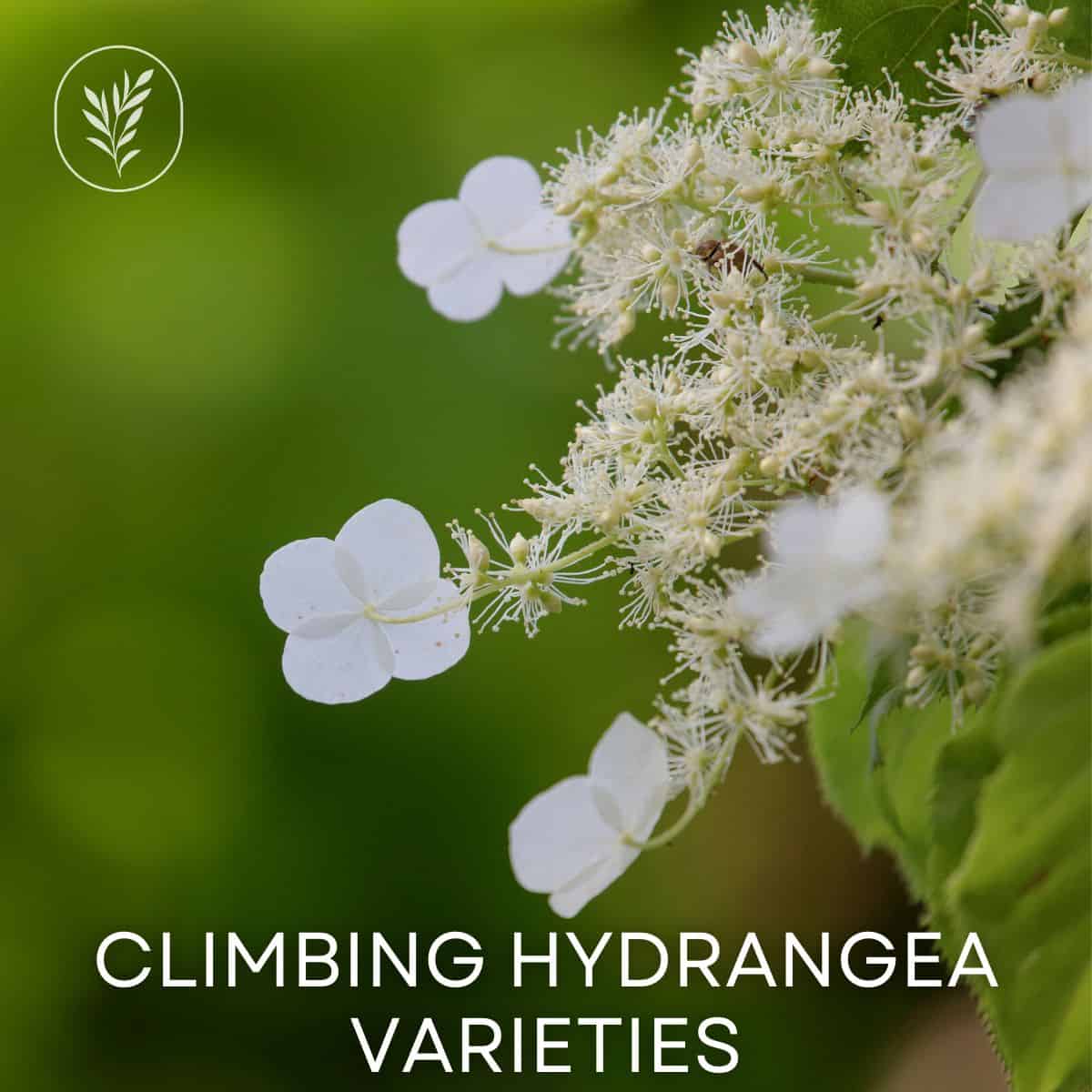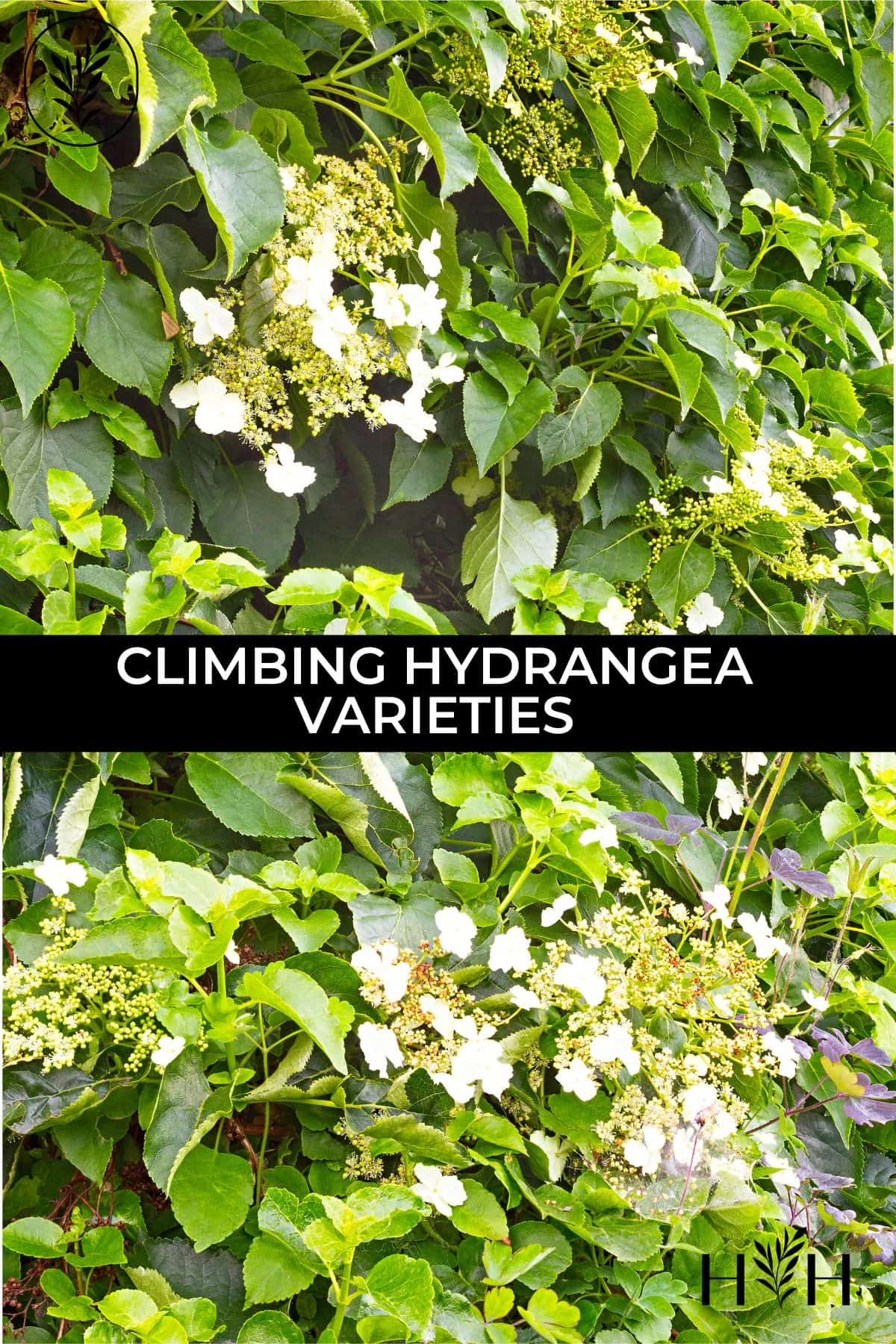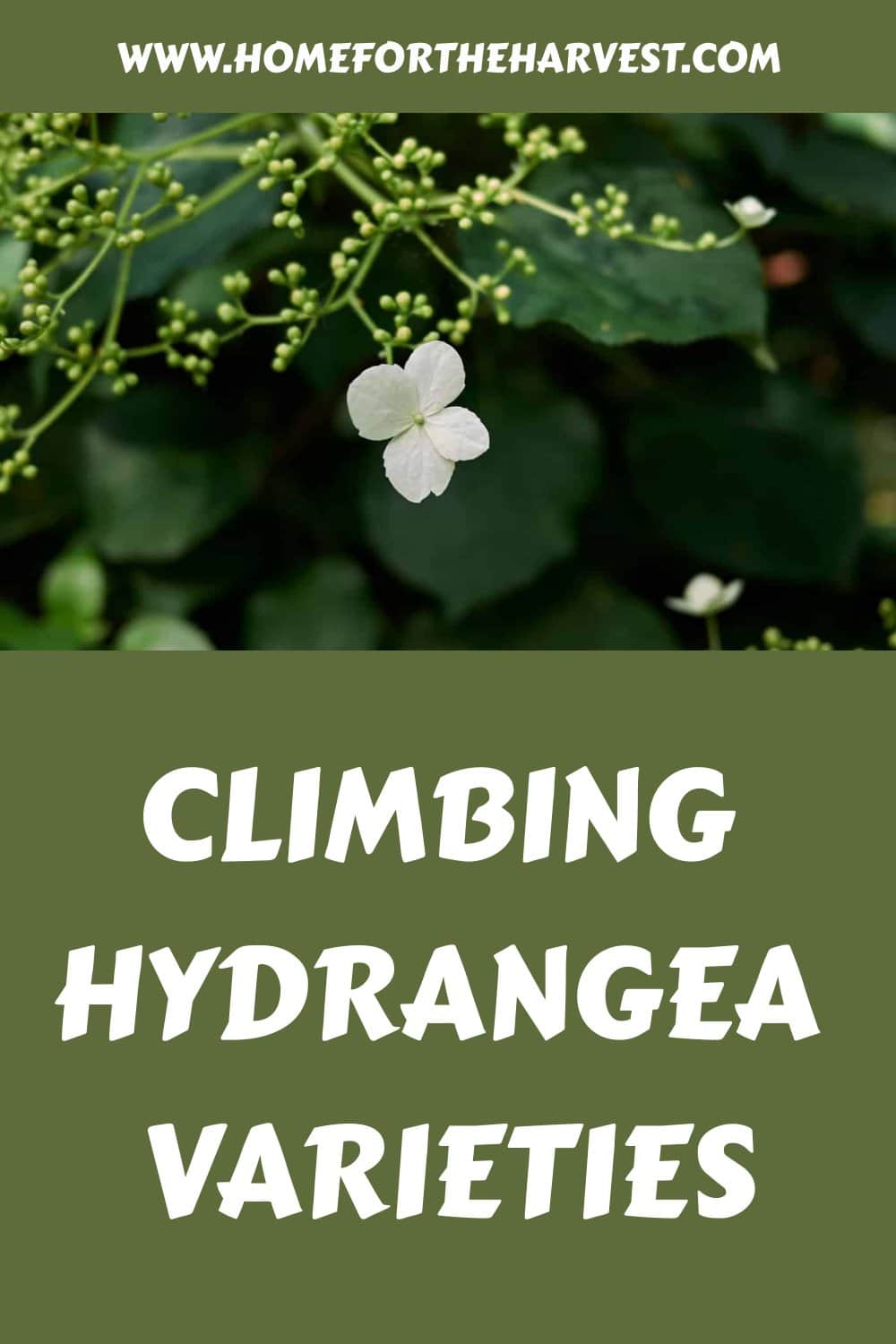Climbing hydrangeas are not available in as many different cultivars as most other types, but there are still quite a few lovely varieties to choose from. From the classic species type Hydrangea petiolaris, to selected cultivars like ‘Miranda’, ‘Silver Lining’, and ‘Flying Saucer’, to rare species climbers, these plants come in many shapes and sizes.
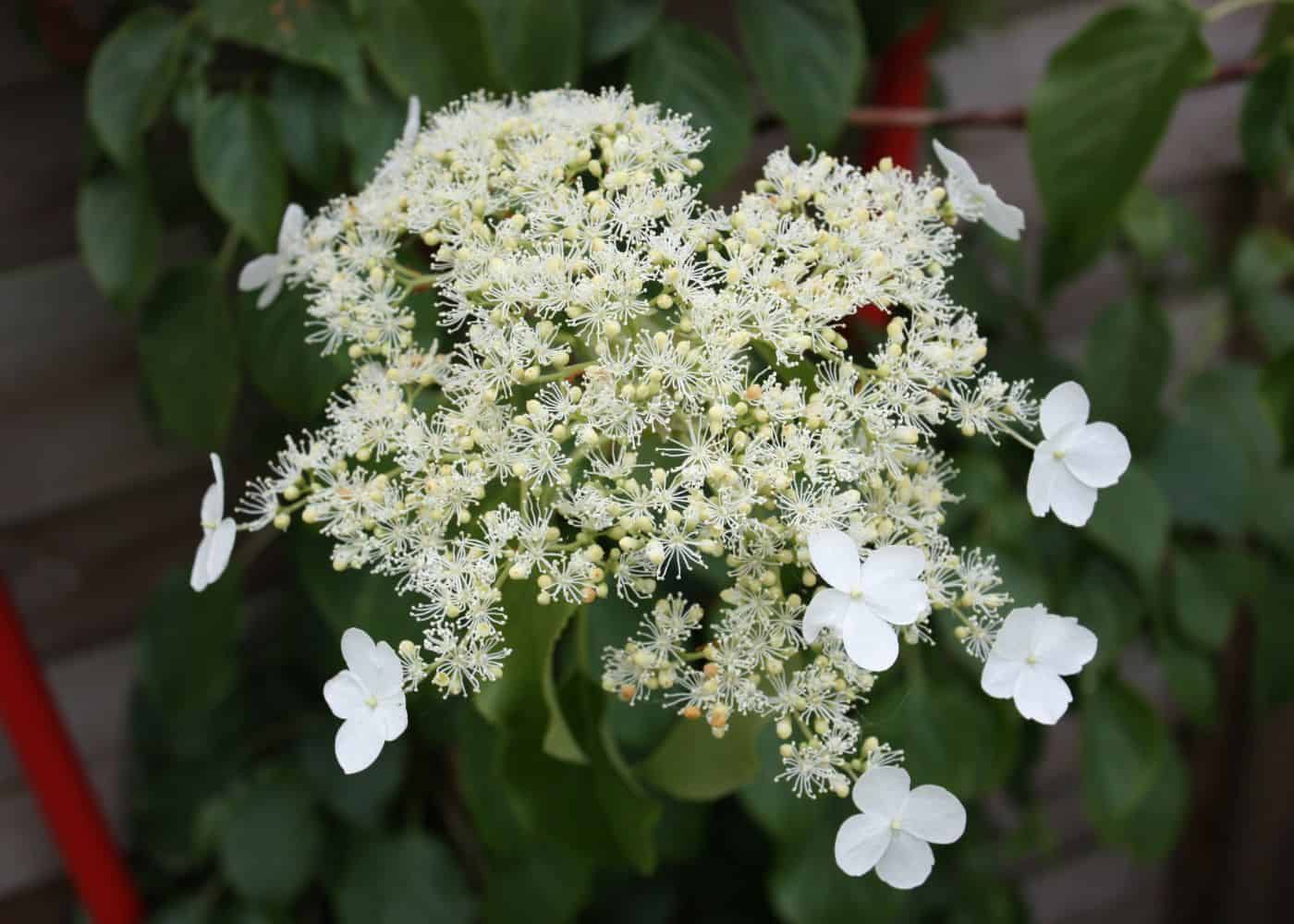
1. Hydrangea petiolaris
Hydrangea petiolaris is the most popular species of climbing hydrangea. Also called Hydrangea anomala subsp. petiolaris, it is a fast-growing, deciduous vine that can reach up to 30-40 feet in height. It has glossy green leaves and white lacecap flowers that bloom in the summertime.
This species of hydrangea plant is native to parts of Japan, Korea, the Kuril Islands, and Sakhalin, but it can be grown successfully in many climates around the world. Hydrangea petiolaris can be grown in USDA zones 4-9.
This climbing species hydrangea is hardy and tolerant of a wide range of soil types. It prefers moist, well-drained soils with plenty of organic matter for best growth. Hydrangea petiolaris will grow best when planted in full sun or partial shade locations; however, too much direct sunlight may cause leaf scorch or damage the foliage during hot summer months.
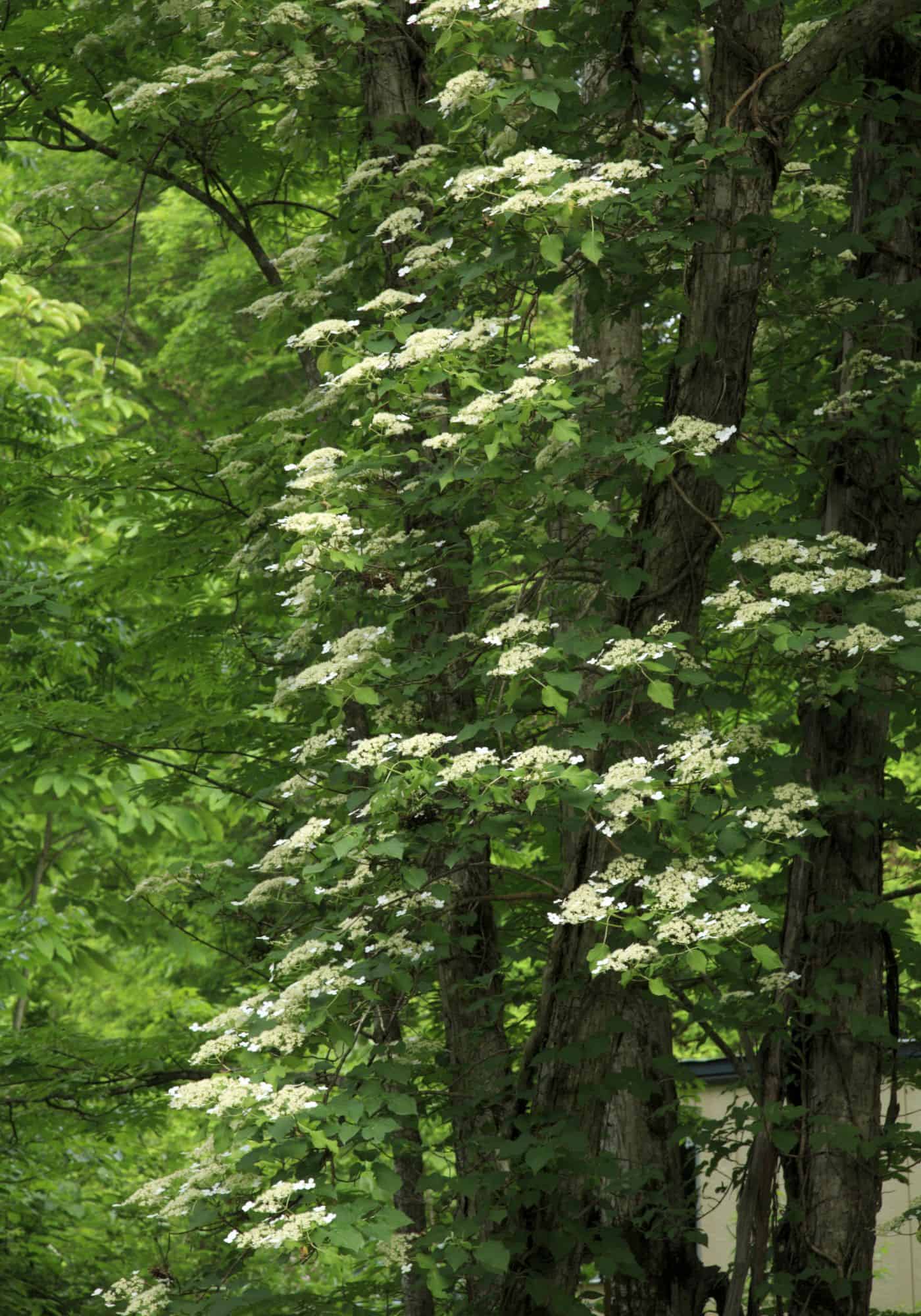
When planting this type of hydrangea, you should use an appropriate trellis or support structure to help guide its growth upward instead of outward on the ground surface, where it could become overgrown and difficult to manage. This type of hydrangea has woody self-attaching stems but grows best with a support trellis. Pruning should be done in the summer after the plant blooms to keep your plant healthy and promote flowering buds for next year’s blooms!
For homeowners looking for a beautiful addition to their garden without having to spend hours tending it every season, Hydrangea petiolaris might just be the perfect match. Once established, this plant requires minimal maintenance other than occasional watering during dry periods as needed.
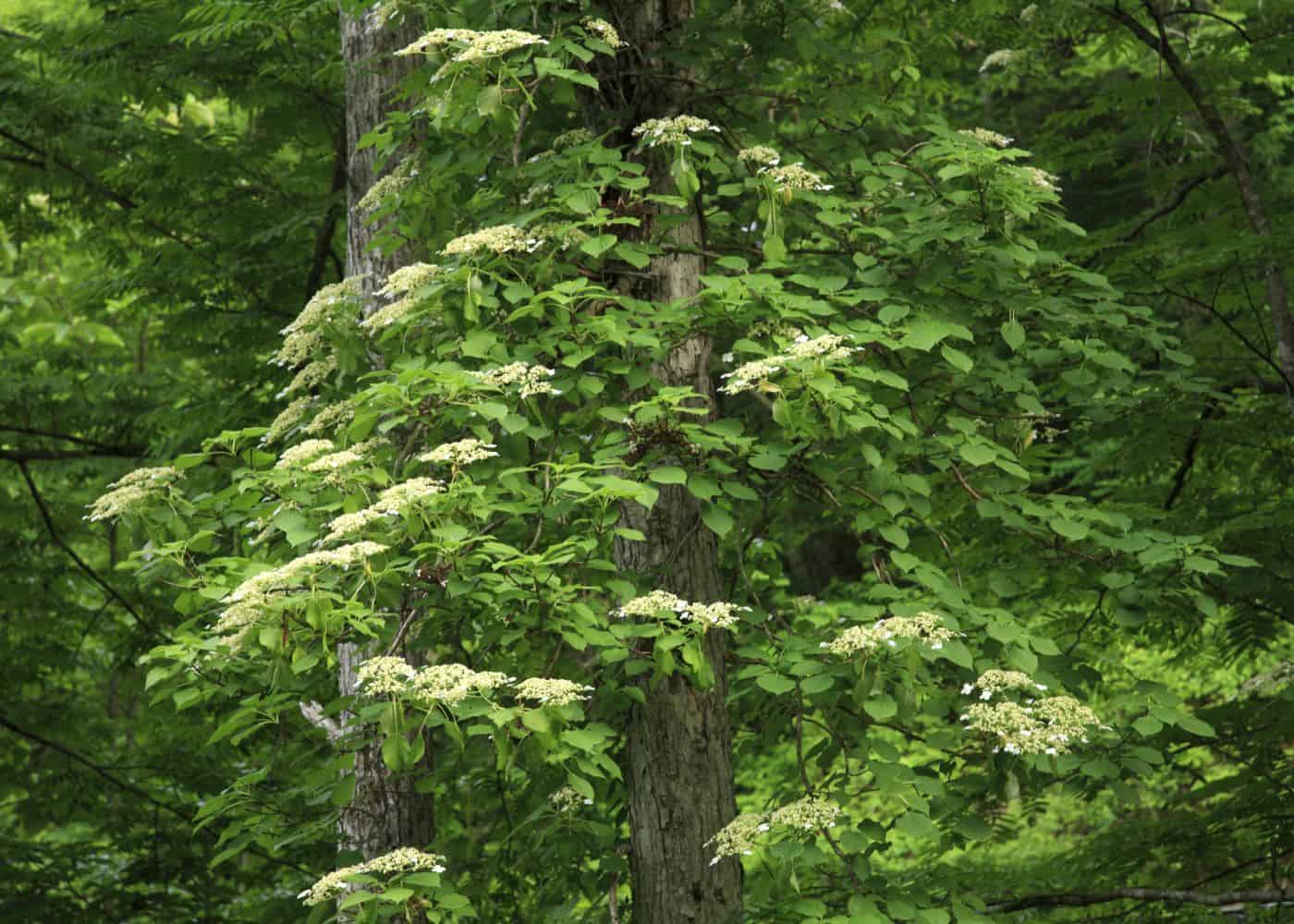
Hydrangea petiolaris is a hydrangea species that blooms on old wood. Avoid winter/spring pruning to enjoy the blooms. It is a beautiful and easy-to-grow climbing hydrangea variety that will bring lush beauty to any garden.
2. Miranda Hydrangea
Hydrangea anomala petiolaris ‘Miranda’ is a selected cultivar of Hydrangea petiolaris. Like the general species type, ‘Miranda’ is a vigorous climbing vine that can be seen clinging to walls, trees, and trellises. It has dark green variegated foliage with yellow to cream-white margins that add texture and interest to any garden. The blooms of this hydrangea are fragrant and white in color, appearing in late spring or early summer.
This plant prefers partial shade but will tolerate some morning sun if given enough water during the hot summer months. Its mature height/length varies depending on its support structure; however, it usually grows about 30 feet tall when trained onto a wall or trellis system.
The flowers of Hydrangea anomala petiolaris ‘Miranda’ have a unique shape compared to many shrub-form hydrangeas. These flowers bloom from May through July and attract butterflies to your garden!
When planting Miranda climbing hydrangeas, make sure you provide them with plenty of organic matter such as composted manure or leaf mold for best results since these plants thrive in nutrient-rich soil conditions. They should also be pruned regularly so they don’t become overgrown, which could lead to disease problems later on down the road. Additionally, keep an eye out for pests like aphids which may feed off the leaves or stems, causing damage if left unchecked!
Hydrangea anomala petiolaris ‘Miranda’ is sold by Monrovia. In Europe, it may be labelled as ‘Mirranda’. This variety may be very similar to a variety called ‘Firefly’ climbing hydrangea, and is a great addition to many landscape designs. Its attractive foliage colors combined with showy, fragrant blooms that appear each year around late springtime add life and beauty to your outdoor space.
3. ‘Silver Lining’ Hydrangea
Hydrangea anomala petiolaris ‘Silver Lining’ is another H. petiolaris cultivar that has become increasingly popular in recent years. This variety of hydrangea produces stunning silver-tinged foliage, making it a great addition to an elegant garden. It’s can be grown in USDA Zones 4-9.
In the spring and early summer months, Hydrangea Silver Lining blooms large white flowers that attract bees and other pollinators. The blossoms are fragrant and long-lasting, providing weeks of enjoyment for gardeners who appreciate their beauty. Plus, this variety is tolerant of most types of soil, so you don’t have to worry about finding the perfect spot for your plant!
When planting Hydrangea Silver Lining in your garden or yard, be sure to give it plenty of room as it can grow up to 20 feet tall when mature. You’ll also want to make sure there’s enough light for the vine; while some shade is preferable (especially in the afternoon), deep shade will diminish flowering and growth. Pruning should be done after the flowering season ends; remove dead wood first before shaping the vine into its desired form if necessary.
If you’re looking for a unique way to add elegant silvery color and texture to your outdoor space without having too much maintenance work involved, then consider adding Hydrangea anomala petiolaris ‘Silver Lining’. Its beautiful foliage will draw attention throughout the year, while its fragrant white flowers bring life into any landscape during summertime.
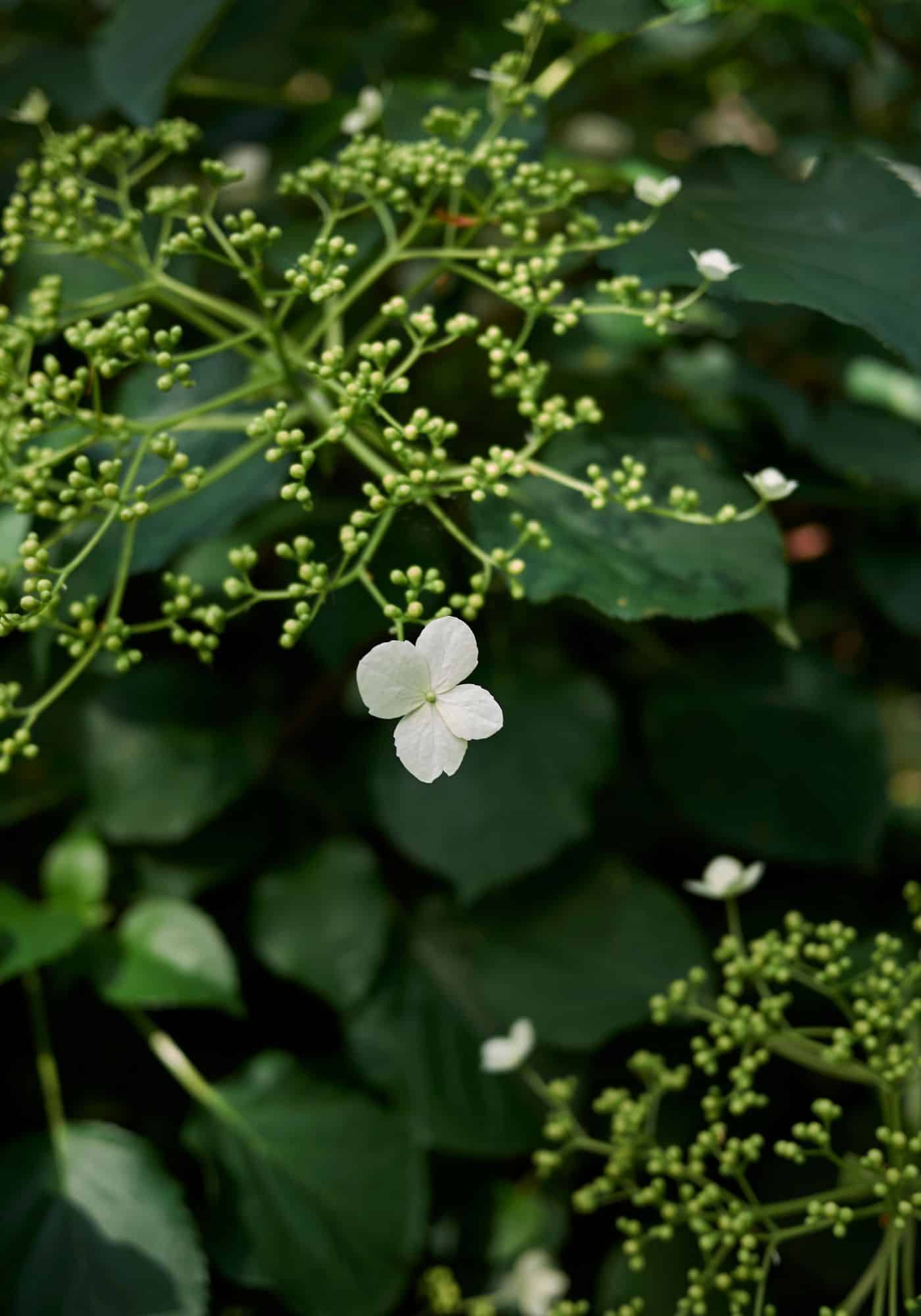
4. ‘Flying Saucer’ Hydrangea
Hydrangea anomala subsp. petiolaris ‘Flying Saucer’ is a selected cultivar of Hydrangea petiolaris with airy, dish-shaped flower heads. It forms clinging aerial roots, allowing it to climb up walls or trees easily (after some initial training at its base).
The leaves are ovate to heart-shaped and range in color from mid to dark green, depending on the season. In summer, the large, slightly-domed clusters of creamy-white flowers will attract pollinators such as bees and butterflies into your garden.
This variety of hydrangea can reach heights of 30-40 feet when mature but can be kept shorter if pruned regularly. It prefers partial shade but will tolerate some direct sun in cooler climates; however, too much direct sunlight may cause its foliage to scorch during hot summers. This plant also needs regular watering during dry spells for optimal growth and flowering performance. Mulching around its base helps retain moisture in the soil and keeps weeds at bay!
If you’re looking for a showstopping addition to your garden, then Hydrangea anomala subsp. petiolaris ‘Flying Saucer’ could be just what you need. This variety of hydrangea is easy to care for and looks great when planted against a wall or trellis, where its clinging aerial roots can spread outwards without taking over other plants nearby. It’s also perfect for covering unsightly fences or structures while adding some beautiful greenery.
5. Hydrangea seemannii
Hydrangea seemannii is a beautiful climbing hydrangea species native to northern regions of Mexico. It can reach heights of 20-40 feet and grows best in warm climates, such as Zones 8-9. This hydrangea species is also self-clinging, meaning it will attach itself to whatever surface it climbs on without additional support. The foliage has an attractive deep green color with oval-shaped leaves.
The flowers of Hydrangea seemannii are white or pinkish in color and have a unique bell shape that blooms from late spring into early summer. These flowers attract butterflies and hummingbirds, which adds even more beauty to this plant! Unfortunately, this species is frost tender, so temperatures below freezing can cause damage to the plant. To protect against unusually cold weather in warm climates, you should cover your Hydrangea seemannii with burlap or other protective material when necessary.
When planting Hydrangea seemannii make sure you choose a spot where there is plenty of sun exposure but also some shade during hot days as too much direct sunlight can be damaging for this particular variety of hydrangeas. Additionally, these plants prefer well-drained soil, so if your area tends to get waterlogged, then consider adding compost or mulch around the base of the plant before planting it to improve drainage conditions and help retain moisture levels throughout dry spells.
For those in warm climates looking for an easy way to add height and interest to their garden space, Hydrangea seemannii is the perfect choice. Its attractive foliage and delicate bell-shaped flowers will bring life to any outdoor space.
6. Hydrangea serratifolia
Hydrangea serratifolia is a climbing hydrangea species native to Chile and Argentina that grows best in warmer climates. It is an evergreen, frost-tender vine that can reach heights of up to 30 feet when mature. The flowers bloom in the summertime and are white or pinkish-white clusters of small blooms.
This plant prefers full sun but will tolerate partial shade as well. It does not require much maintenance other than occasional pruning for shape control if desired, although it can become overgrown if left unchecked for too long. Hydrangea serratifolia likes moist soil but should be watered sparingly during periods of drought or heat waves to avoid root rot or leaf burn from excessive water exposure. Fertilizing this plant once every two months during the growing season will help keep it healthy and vigorous throughout the year.
In terms of pests, this variety is relatively pest resistant; however, insects may occasionally feed on its foliage so regular monitoring is recommended to ensure that any infestations are dealt with quickly before they spread further into your garden space. This species also benefits from mulching around its base which helps retain moisture in the soil while protecting against weeds competing for nutrients and sunlight.
Overall, Hydrangea serratifolia is an excellent addition to any garden due to its hardiness, low maintenance requirements, and beautiful foliage and flower display each summertime.
7. Hydrangea hydrangeoides
Hydrangea hydrangeoides, also known as Japanese Hydrangea Vine, is a liana native to Korea, the Kuril Islands, and Japan. This hydrangea species was recently classified as a true hydrangea after being classed with false hydrangeas.
This vine grows up to 40 feet in length with large heart-shaped leaves that are glossy green on top and fuzzy white underneath. The flowers bloom in summertime, usually between June and August, with creamy white petals surrounding clusters of tiny yellow stamens at the center.
When it comes to planting this hydrangea, it prefers moist soil that drains well but can tolerate dry conditions if necessary. It does best when planted in full sun or partial shade areas where temperatures remain moderate throughout the year; however, it can be grown indoors as long as there is plenty of light available for growth.
In terms of care requirements for Hydrangea hydrangeoides, regular pruning will help keep its shape while promoting healthy growth over time. Fertilizing once every two weeks during springtime helps promote blooming while providing essential nutrients for overall healthiness too! Additionally, water regularly, but don’t let the soil become soggy since this could lead to root rot or other issues down the line.
Hydrangea hydrangeoides is an excellent choice for those looking to add a touch of elegance and beauty to their garden.
8. Hydrangea integrifolia
Hydrangea integrifolia is a species of flowering epiphyte native to Taiwan and the Philippines. It grows best in temperate climates, preferring cooler temperatures with ample rainfall. This evergreen vine produces large clusters of white flowers that bloom from late spring through early summer. The foliage is glossy green and deeply lobed, giving it an attractive appearance all year round.
This hydrangea variety does well in partial shade as long as there is adequate drainage for its roots. When planted in ideal conditions, Hydrangea integrifolia will spread quickly over fences or trellises due to its climbing habit. Pruning should be done regularly to maintain desired shape and size; however, this plant responds very well to pruning so you don’t have to worry about being too aggressive when trimming back branches or stems.
Its bright blooms bring life into any outdoor area while providing much-needed privacy during the warmer months of the year. When planting this vine near other plants or structures, such as patios or decks, make sure to leave enough room for its growth potential since it can easily overtake smaller plants if not given enough space.
Hydrangea integrifolia is a beautiful and versatile climbing hydrangea variety that can be used to add beauty and charm to any garden. Next, we’ll explore the benefits of Hydrangea petiolaris.
9. Hydrangea glaucescens
Hydrangea glaucescens, previously classified as Schizophragma elliptifolium, is a true hydrangea native to southeastern China. Commonly called Chinese Hydrangea Vine, it is a climbing shrub with mature height/length of up to 20-40 feet. Its foliage usually has an ovate to elliptical shape with pointed tips and serrated edges. Its flowers are creamy-white lacecap-like clusters.
The plant prefers partial shade or dappled sunlight but can tolerate full sun if given enough water. It does best in well-drained soil that is slightly acidic or neutral pH levels. Hydrangea glaucescens should be pruned regularly to maintain its desired size and shape; however, it can become unruly if not properly managed, so regular maintenance is recommended for optimal results.
This species of hydrangea makes an excellent addition to any garden due to its attractive foliage and long blooming season. If you can find them, planting multiple specimens together will create a stunning display of cascading vines with fragrant blossoms sure to delight passersby. The plant also attracts pollinators such as bees, butterflies, and hummingbirds which helps promote biodiversity in your garden while providing you with beautiful blooms all summer long.
10. Hydrangea albostellata
Hydrangea albostellata is a recently named native to the southern regions of Mexico and Central America (Costa Rica, El Salvador, Guatemala, Honduras, Nicaragua). It grows in the wet tropical biome, where it can reach heights of up to 35 feet as it climbs. This species produces small white flowers that are clustered together in umbels at the end of each stem. The foliage consists of large, glossy dark green leaves.
This plant prefers moist soil and partial shade under the forest canopy. This plant is mainly found in nature and rarely sold in garden centers. The best way to propagate this plant is through cuttings taken from healthy stems in late spring or early summer when new growth begins appearing on the vine. Hydrangea albostellata is rare in cultivation, but certainly worth investigating!
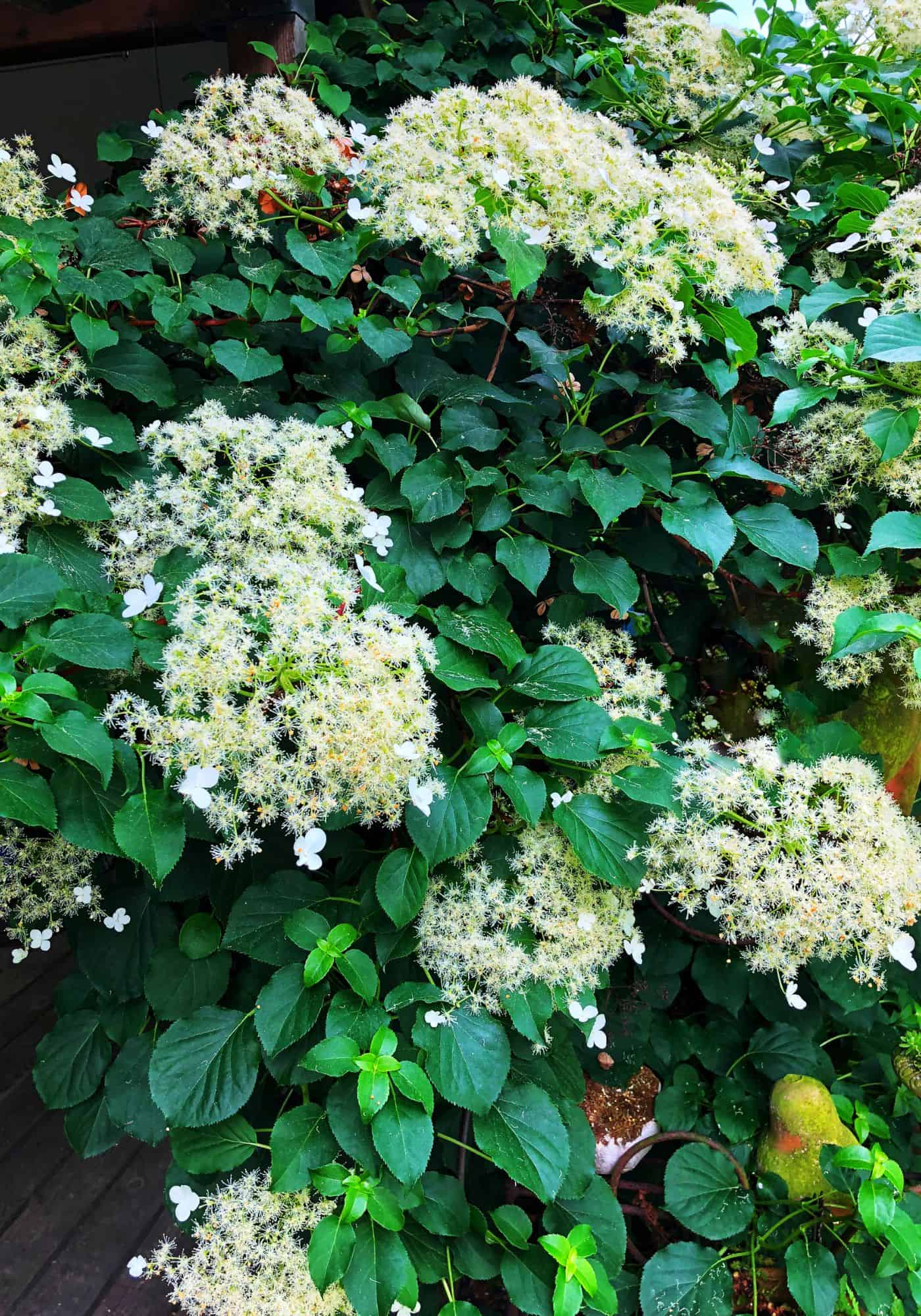
More to choose from
Here are some more varieties of climbing hydrangea to choose from:
- Skylands Giant climbing hydrangea (Hydrangea petiolaris ‘Skylands Giant’)
- Aurea climbing hydrangea (Hydrangea petiolaris ‘Aurea’)
- Sutter’s Mill climbing hydrangea (Hydrangea petiolaris ‘Sutter’s Mill’)
- Kuga Variegated climbing hydrangea (Hydrangea petiolaris ‘Kuga Variegated’)
- Furuaziai climbing hydrangea (Hydrangea petiolaris ‘Furuaziai’)
- Kasai climbing hydrangea (Hydrangea petiolaris ‘Kasai’)
- Winter Glow climbing hydrangea (Hydrangea anomala ‘Winter Glow’)
- Crug Coral climbing hydrangea (Hydrangea glabra ‘Crug Coral’)
FAQs about climbing hydrangea varieties
Which is the best climbing hydrangea?
The best climbing hydrangea for North American gardens is Hydrangea anomala subsp. petiolaris, commonly labeled as “Climbing Hydrangea.” This hardy vine can reach heights of up to 30 feet and produces beautiful white lace cap flowers in late spring or early summer.
Most plants at the garden center are general species (not named cultivars). That said, Monrovia now offers a cultivar called ‘Miranda’, and in Europe, it is possible to find ‘Flying Saucer’ and ‘Silver Lining’.
This species is easy to grow and requires minimal maintenance, making it a great choice for busy homeowners who want to add beauty and color to their gardens without having to be a gardening expert. The Climbing Hydrangea will thrive in partial shade, making it ideal for many mild North American climates.
Which hydrangeas are climbers?
There are several species of hydrangeas that can be used as climbers. The most popular and widely available types include the Hydrangea anomala petiolaris species hydrangea and its cultivars. The cultivar ‘Miranda’ is offered in North America by Monrovia, while ‘Silver Lining’, ‘Flying Saucer’, and ‘Crûg Coral’ are more commonly found in Europe.
Hydrangea seemanii, Hydrangea serratifolia, and the other species listed above are less commonly found in garden centers, but may be viewable in a botanical garden.
Will climbing hydrangea grow in full shade?
Climbing hydrangeas generally will grow in full shade, but will not grow vigorously or flower well. They need at least a few hours of sunlight (preferably in the morning) to thrive and produce flowers. It is best to choose a spot with only partial shade for your climbing hydrangea so it can get enough light while still being sheltered from intense heat and strong winds.
Is there an evergreen climbing hydrangea?
Evergreen climbing hydrangea species include Hydrangea serratifolia and Hydrangea integrifolia. These species can be hard to find and are generally only grown by collectors or in botanical gardens.


